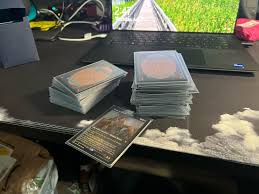Shuffling in Magic: The Gathering Isn’t What You Think—And You’re Probably Doing It Wrong

Turns out, most MTG players—even pros—don’t shuffle properly. High-speed camera footage and insights from casino-grade mathematicians show the majority of us get it wrong about 9 times out of 10. So if your draws feel cursed, it might not be your deck—it might be your shuffle.Let’s pull back the curtain.
Common Shuffling Beliefs That Don’t Hold Up
Belief #1: Seven riffles are enough
You’ve probably heard that seven riffles randomize a deck. That idea’s been floating around forever. But it only holds up under perfect conditions—cards of equal thickness, no sleeves, precise split every time. In real play, even skilled hands fall short. Proper randomization? Think more like 12+ good riffles. Most folks do about 4 to 6. That leaves chunks of cards—like land pockets—completely intact.
Belief #2: Pile shuffling mixes the deck
Let’s be clear: pile shuffling has nothing to do with randomizing. It’s just a counting trick. You’re moving stacks around, sure, but the order of the cards? Barely changed. If you use it, use it for checking your card count, not for mixing.
Belief #3: Mash shuffling does the trick
When you mash with sleeves, you’re up against serious resistance. That friction limits how deeply cards interweave. While mashing is common (and faster), you’d need 17 or more well-executed mashes to match a few proper riffles. Most players don’t even come close.
Want True Randomization? Here’s What Casinos Recommend
If you’ve ever watched a casino dealer, they’re not winging it. Their method is built to eliminate patterns and bias. It works for card games—and it works for MTG too.
1. Start with a Wash – Spend 30 seconds spreading the cards face-down and mixing them chaotically on the table. Swirl them. Flip them. Break up any lingering order.
2. Riffle in Stacks – Do four riffle shuffles, using a true middle split. Try to overlap cards about 50% on each side.
3. Finish With Mashes – Do 10 corner-to-corner mashes. Alternate the direction. This reduces the impact of sleeve friction and breaks habitual movement patterns.
Yes, it takes a couple of minutes. But it’s worth it.
Why All This Matters More Than You Think
Bad shuffles aren’t just casual mistakes—they cause real gameplay issues. Clumped lands, mana floods, non-games… most of these aren’t due to “bad luck.” They’re mechanical flaws.In higher-level play, not shuffling properly is treated like cheating—even if it’s not intentional. If you’re sitting down at a competitive event and not thoroughly mixing your deck, you might be putting yourself (or your opponent) at an unfair advantage.According to analysis from deck tech researchers, properly randomized decks reduce non-games—matches decided by nothing but bad variance—by up to 38%.
Pressed for Time? Here’s a Faster Fix
If the round’s about to start and you don’t have two minutes, try this:Do a quick 15-second wash shuffleRiffle three times (aim for good overlap)Mash five times, changing angles as you goLet your opponent cut—make sure it’s more than just a top cut. Ask for a deep one (7+ cards).This isn’t perfect, but it’s a lot better than doing nothing.
Frank Karsten once said:“Most players don’t get mana screwed—they get shuffle screwed.”
Want to Level Up Your Shuffle Game?
Using the right tools can help. Quality mats, friction-friendly sleeves, and structured shuffling techniques all make a difference. Mtgetsy.com offers resources that some of the best players use to make their prep more consistent and effective.
Before You Play Tonight—Try This
Set your phone up and record yourself shuffling. Just once. Watch it back and look for repeat habits: cutting the same place, mashing in the same direction, stacking the same way. Most players are shocked when they see their patterns.
Final Note for the Double-Sleeved Crowd
If you’re running double sleeves (and many are these days), keep this in mind: it takes around 22% more effort to properly randomize your deck compared to single-sleeved lists. The added thickness and friction slow the shuffle down. Factor that in when you’re prepping before a game.
How do you shuffle?Got a method that works or a horror story of never drawing lands? Share your experience below.



